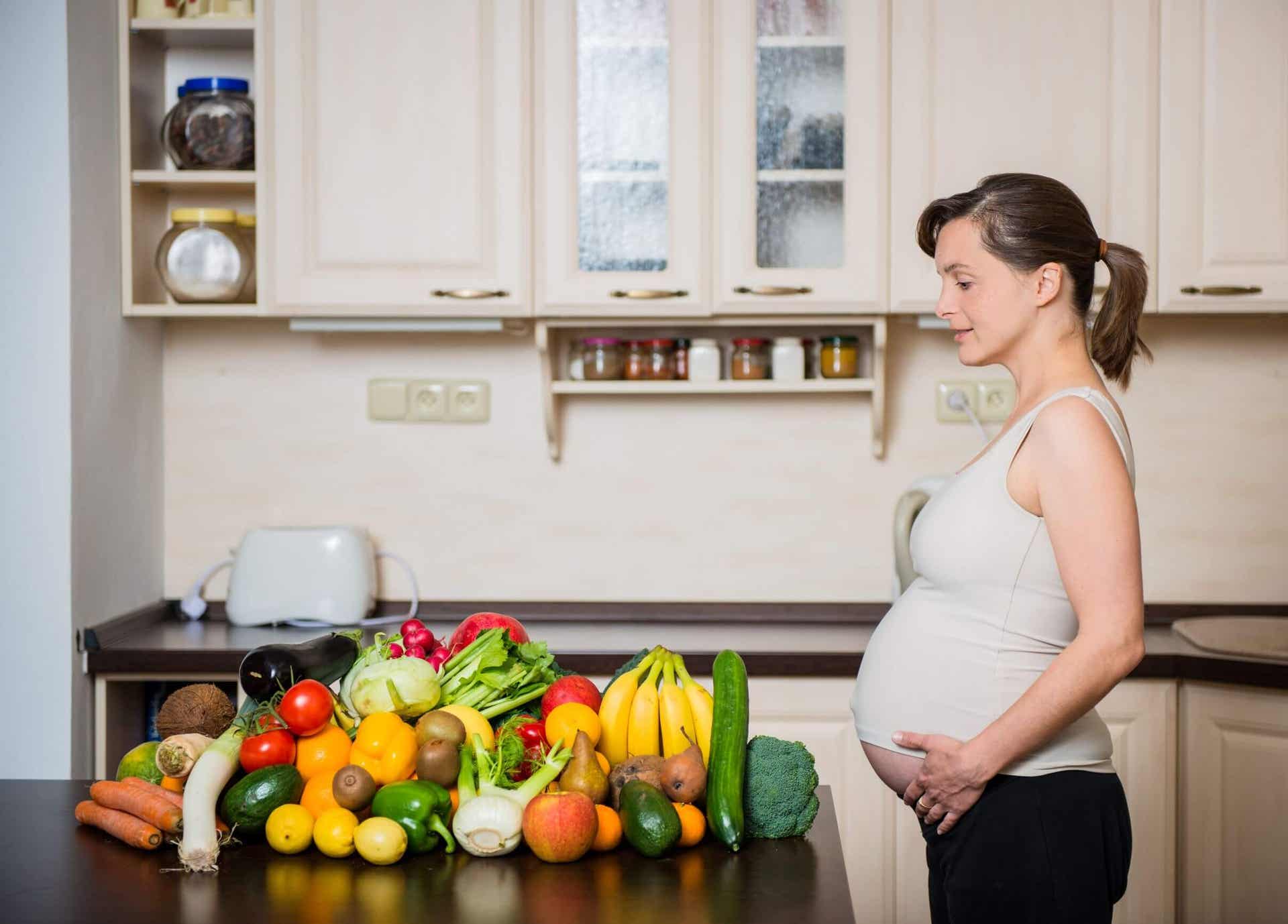The Importance of Green Leafy Vegetables During Pregnancy


Written and verified by the nutritionist Silvia Zaragoza
Did you know that a woman’s nutritional needs increase during pregnancy? That’s why doctors prescribe supplements like folic acid when there’s an inability to cover them through food. It’s a vitamin that’s involved in the development of the future baby, so it’s essential to include them daily during the 9 months of gestation. For this reason, we want to explain why it’s important to eat green leafy vegetables during pregnancy.
Folic acid belongs to the family of B vitamins and is water soluble. In addition, it’s responsible for forming the corpus luteum, characterized by its yellow color, allowing the fetus to develop. It’s also involved in DNA synthesis and cell division, so it’s essential to meet daily needs.
Fetal malformations, the main reason for eating green leafy vegetables during pregnancy
The formation and closure of the neural tube, produced during fetal growth, are essential to avoid neurological problems and spina bifida. Respectively, they manifest themselves through lack of coordination and thinking, as well as difficulty walking. As a consequence, there’s an increased risk of miscarriage.

Folate deficiency anemia
Although the most well-known type of anemia is caused by iron deficiency, vitamin B9 and B12 deficiency are the main cause of megaloblastic anemia. It’s manifested by an increase in the size of red blood cells and a decrease in their intense red color.
As a result, it reduces the transport of oxygen and blood to the tissues. It presents itself through gastrointestinal symptoms such as diarrhea, swelling of the tongue due to inflammation, and loss of appetite.
In addition, together with vitamin B6 and B12, they prevent homocysteine from accumulating in the blood. Homocysteine is a protein derived from methionine metabolism and its excess has been linked to increased cardiovascular risk.
Other reasons to eat leafy green vegetables during pregnancy
Although neural tube defects and anemia are the most well-known negative effects of vitamin B9 deficiency, there’s evidence of other consequences.
A study carried out in China claims that supplementation and intake over 12 weeks decreases the risk of premature birth.
As a result of the appearance of these pathologies, many countries have opted to fortify foods. However, some still don’t do so and this is where the relationship with the appearance of asthma in children has been seen.
For this reason, they decided to carry out their research in a country that does carry out this practice of fortifying food, such as the United States. Although there was a lower incidence of asthma, it’s important to point out that it’s a respiratory disease associated with genetic and environmental factors, which could alter the results. Thus, more well-controlled studies are necessary.
Finally, it’s been associated with increased blood pressure or preeclampsia. Normally, it’s multifactorial, such as family history, being over 35 years old, obesity, and multiple pregnancy. However, increasing folic acid intake helps to reduce its occurrence after supplementation of 4 micrograms per day for 3 months.
How to incorporate green leafy vegetables on a daily basis?
Now that you know the above, why not try including more vegetables in your diet? Here are some ideas and tips to enjoy. Remember that this food group is the basis of a healthy diet.

Or, make some steamed chard or broccoli and then sauté it with a little garlic and paprika or some chopped almonds with parsley and lemon zest.
In addition, oat flakes also contain folates, and you can eat them daily. In chickpea or lentil stews with vegetables, they’re delicious! Or you can make cooked oatmeal with milk or a plant-based milk with a stick of cinnamon and lemon zest. So, what are you waiting for?
Did you know that a woman’s nutritional needs increase during pregnancy? That’s why doctors prescribe supplements like folic acid when there’s an inability to cover them through food. It’s a vitamin that’s involved in the development of the future baby, so it’s essential to include them daily during the 9 months of gestation. For this reason, we want to explain why it’s important to eat green leafy vegetables during pregnancy.
Folic acid belongs to the family of B vitamins and is water soluble. In addition, it’s responsible for forming the corpus luteum, characterized by its yellow color, allowing the fetus to develop. It’s also involved in DNA synthesis and cell division, so it’s essential to meet daily needs.
Fetal malformations, the main reason for eating green leafy vegetables during pregnancy
The formation and closure of the neural tube, produced during fetal growth, are essential to avoid neurological problems and spina bifida. Respectively, they manifest themselves through lack of coordination and thinking, as well as difficulty walking. As a consequence, there’s an increased risk of miscarriage.

Folate deficiency anemia
Although the most well-known type of anemia is caused by iron deficiency, vitamin B9 and B12 deficiency are the main cause of megaloblastic anemia. It’s manifested by an increase in the size of red blood cells and a decrease in their intense red color.
As a result, it reduces the transport of oxygen and blood to the tissues. It presents itself through gastrointestinal symptoms such as diarrhea, swelling of the tongue due to inflammation, and loss of appetite.
In addition, together with vitamin B6 and B12, they prevent homocysteine from accumulating in the blood. Homocysteine is a protein derived from methionine metabolism and its excess has been linked to increased cardiovascular risk.
Other reasons to eat leafy green vegetables during pregnancy
Although neural tube defects and anemia are the most well-known negative effects of vitamin B9 deficiency, there’s evidence of other consequences.
A study carried out in China claims that supplementation and intake over 12 weeks decreases the risk of premature birth.
As a result of the appearance of these pathologies, many countries have opted to fortify foods. However, some still don’t do so and this is where the relationship with the appearance of asthma in children has been seen.
For this reason, they decided to carry out their research in a country that does carry out this practice of fortifying food, such as the United States. Although there was a lower incidence of asthma, it’s important to point out that it’s a respiratory disease associated with genetic and environmental factors, which could alter the results. Thus, more well-controlled studies are necessary.
Finally, it’s been associated with increased blood pressure or preeclampsia. Normally, it’s multifactorial, such as family history, being over 35 years old, obesity, and multiple pregnancy. However, increasing folic acid intake helps to reduce its occurrence after supplementation of 4 micrograms per day for 3 months.
How to incorporate green leafy vegetables on a daily basis?
Now that you know the above, why not try including more vegetables in your diet? Here are some ideas and tips to enjoy. Remember that this food group is the basis of a healthy diet.

Or, make some steamed chard or broccoli and then sauté it with a little garlic and paprika or some chopped almonds with parsley and lemon zest.
In addition, oat flakes also contain folates, and you can eat them daily. In chickpea or lentil stews with vegetables, they’re delicious! Or you can make cooked oatmeal with milk or a plant-based milk with a stick of cinnamon and lemon zest. So, what are you waiting for?
All cited sources were thoroughly reviewed by our team to ensure their quality, reliability, currency, and validity. The bibliography of this article was considered reliable and of academic or scientific accuracy.
- Salas-Salvadó, J; Bonada Sanjaume, A; Trallero CAsañas, R; Saló Solà, ME; Burgos Peláez, R (2014) Nutrición y Dietética Clínica. 3ª edición (Barcelona) Editorial EL Servier.
- Llamas Centeno,M J; Miguélez Lago, C (2016) Folic acid: Primary prevention of neural tube defects. Literature Review. Arch Esp Urol, 69(2): 73-83.
- van Gool, J D; Hirche, H; Lax, H; De Schaepdrijver, L (2018) Folic acid and primary prevention of neural tube defects: A review. Reprod Toxicol, 80:73-84.
- Radziejewska, A; Chmurzynska, A (2019) Folate and choline absorption and uptake: Their role in fetal development. Biochimie, 158: 10-19.
- Green, R; Datta Mitra, A (2017) Megaloblastic Anemias: Nutritional and Other Causes. Med Clin North Am, 101(2): 297-317.
- Djuric, D; Jakovljevic, V; Zivkovic,V; Srejovic, I (2018) Homocysteine and homocysteine-related compounds: an overview of the roles in the pathology of the cardiovascular and nervous systems. Can J Physiol Pharmacol, 96(10): 991-1003.
- Liu, X; Lv, L; Zhang, H; Zhao, N; Qiu, J; Xiaochun He,X et al (2016) Folic acid supplementation, dietary folate intake and risk of preterm birth in China. Eur J Nutr, 55(4): 1411-22.
- Trivedi, M K; Sharma, S; Rifas-Shiman, S L; Camargo Jr, C A; Weiss, S T; Oken, E et al (2018) Folic Acid in Pregnancy and Childhood Asthma: A US Cohort. Clin Pediatr, 57(4): 421-27.
- Zheng, L; Huang, J; Kong, H; Wang, F; ¡Su, Y; Xin, H(2020) The effect of folic acid throughout pregnancy among pregnant women at high risk of pre-eclampsia: A randomized clinical trial. Pregancy Hipertens, 19:253-58.
- Bulloch, R E; Lovell, A L; B Jordan, V M; E McCowan, L M; D Thompson, J M; Wall, C R (2018) Maternal folic acid supplementation for the prevention of preeclampsia: A systematic review and meta-analysis. Paediatr Perinat Epedemiol, 32(4): 346-57.
This text is provided for informational purposes only and does not replace consultation with a professional. If in doubt, consult your specialist.








